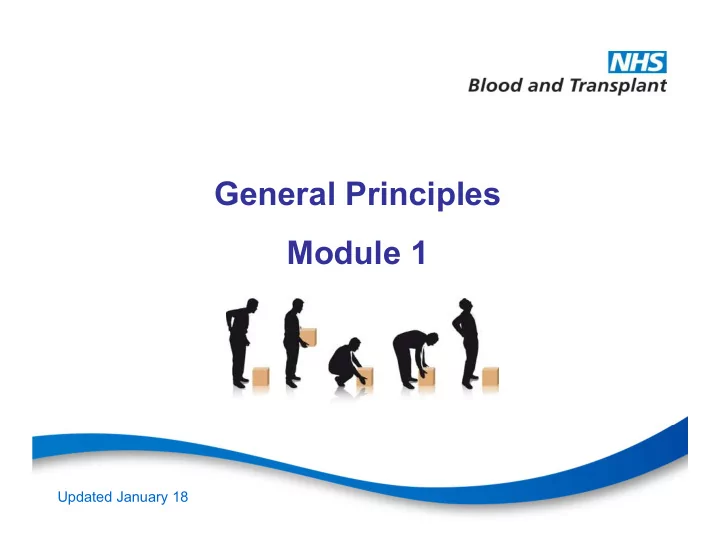

General Principles Module 1 Updated January 18
Learning outcomes By the end of this training you will be able to: • Know basic legislation and definitions • Recognise how injuries are caused and which parts of the body are affected by injuries • Know the importance of using the semi squat lift and how to adapt it • Know the importance of increased postural awareness in order to reduce injuries
Manual Handling? What is Manual Handling: The transportation or supporting of a load (including lifting, putting down, pushing, pulling, carrying or moving) by hand or by bodily force The term ‘load’ includes objects, people and animals. Manual Handling Operations Regulations 1992 (as amended)
Work and Home
Manual Handling Level 4 by Directorate 80 70 70 60 50 40 30 16 20 7 6 5 10 2 1 1 1 0 Blood Donation Blood Manufacturing Diagnostic and Group Services (GS) Organ Donation and and Logistics Therapeutic Services Transplantation (ODT) (DTS) Near Miss Non-Reportable
Manual Handling Level 1, 2 & 3 by Directorate 25 23 20 15 10 6 5 3 3 2 1 0 Level 1 Level 2 Level 3 Blood Donation Blood Manufacturing and Logistics Diagnostic and Therapeutic Services (DTS)
Manual Handling Operations Regulations 1992 • Carry out general risk assessment (MH&SW Regs) • Avoid significant risks if possible • Consider mechanical or automated process • If task cannot be avoided or automated carry out risk assessment in accordance with the MHOR • Record findings and produce SSW • Provide training to employees
MHOR 1992 Duties of the Employees Employees are legally required to: • Take reasonable care of their own health and safety and that of their colleagues and clients • Use available work and safety equipment, in accordance with the training and instruction provided • Follow appropriate systems of work laid down by the employer in their manual handling policy • Use proper channels to inform management of possible hazards or shortcomings in manual handling activities .
The Spine
Spine • Load evenly distributed • Reduces compression on the spine • Neutral position • Muscles balanced • Reduces tension on tissues • Face direction of travel (no twisting).
Anatomy and Biomechanics
Causes of Back Pain
Biomechanics Demonstration
Childs play
What lift is best?
Practical – Semi-squat lift • Assess • Feet • Knees • Hips • Back • Head and neck • Grip • Load close • Put down
Understanding Postures Finger / thumb pinch grip Palm grip Grasp grip
Sitting/Standing • Any sustained posture over time is fatiguing • Generally sitting is generally less fatiguing • Unsupported sitting positions encourage poor posture and should be avoided • Standing should be alternated with sitting whenever possible
Use separate keyboard and mouse Healthy Sitting • Maintain an “S” shaped spine • Wherever possible ensure that your back is supported • Feet flat on the floor • Avoid Twisting • Stand up and Stretch where possible • Do not remain in a ‘static’ sitting position for a long period of time • Adopt good posture whilst carrying out driving tasks Adjust your chair back so that your back is supported Screen at eye level with correct use of riser Adjust your chair height so that your feet are flat on floor
Healthy Standing • Maintain an “S” shaped spine • Avoid working in a stooped posture • Avoid repeatedly bending and twisting Bad Good
Simple Exercises Upper and Lower Back Wrists, Hands and Arms
Simple Exercises Upper and Lower Back Photo to be added Shoulder Stretch
Manual Handling Yearly Observation Name ………………………………………………… Team ………………………………………………… Equipment observed lifting ………………………………………………… Manual Handling Trainer ………………………………………………… Activity Y/N Comments: Good practice and improvements Assess load Prepare route Position feet Stable base Bend knees Back straight Head back, chin in, neck neutral Good grip Load close Load put down safely Manual Handling Trainer Signature ………………………………………………… Date …………………………………………………
To sum up : Your Role
Learning outcomes By the end of this training you will be able to: • Know basic legislation and definitions • Recognise how injuries are caused and which parts of the body are affected by injuries • Know the importance of using the semi squat lift and how to adapt it • Know the importance of increased postural awareness in order to reduce injuries
Recommend
More recommend